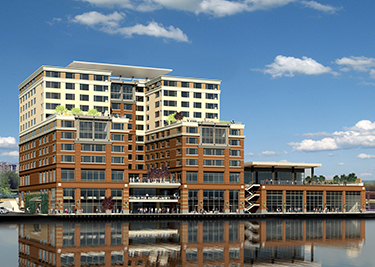|
Subscribe / Renew |
|
|
Contact Us |
|
| ► Subscribe to our Free Weekly Newsletter | |
| home | Welcome, sign in or click here to subscribe. | login |
Environment
| |
 |
February 26, 2015
How to make a better business case for going green
MulvannyG2 Architecture

Hand
|
What do investors and CEOs have in common? Both groups see sustainability as a clear competitive advantage for businesses, according to a 2014 study from the Principles for Responsible Investment (PRI).
However, the study also discovered a major disconnect in business leaders’ abilities to communicate to investors how sustainability translates into business value. Only 38 percent of CEOs surveyed believe they can accurately place a business value on sustainability and just 7 percent of investors are in agreement.
If business leaders can’t find a better way to quantify and communicate this information, this issue will likely hinder the progress and profitability of sustainable development.
Read the study online at bit.ly/1zXUpwU.
This topic is particularly relevant in the greater Seattle real estate market, where many developers are seeking ways to add value and attract more business through sustainability. There aren’t many places like Seattle, where you can say that LEED silver certification is becoming more of a market expectation than a striking differentiator. Seattle and Washington state rank in the top 10 for certified projects and registrations, according to the U.S. Green Building Council.
What these developers and investors understand is that sustainability produces tangible business results. This occurs through better stakeholder engagement, longer-term orientation for projects, increased user satisfaction, and enhanced communication through measurement and disclosure of information such as energy use.
Further, an organizational focus on sustainability can create opportunities to attract better employees, strengthen ties with the community, and foster a culture of continuous improvement. The global nonprofit organization CDP reports that businesses that are actively managing and planning for climate change report an 18 percent higher return on investment than those that are not.
So why are business leaders struggling to discuss the value of sustainability with investors? There are many factors at play, from a lack of consistent metrics and information to “greenwashing,” or the deceptive use of sustainability claims.
Making the business case for sustainability to real estate investors requires narrowing your focus on communication, investing in the right people, and becoming engaged in policymaking.
Clearer communication
In order to better communicate with potential real estate investors it’s important to first cultivate a common language. To do this, the development community needs to work together to track and communicate a shared set of metrics around sustainability that can build a foundation for the conversation about value.
The need for this foundation was highlighted at a recent NAIOP Washington event during a discussion about an important metric to real estate investors: property valuation. The issue at hand was that the appraisal community is lagging behind the sustainability movement, and measures that go beyond complying with the energy code often go unnoticed in valuing a property.
In order for properties to be appraised and compared more appropriately, sustainability metrics must be treated with the same rigor and consistency as other financial measures. In the recent PRI study, 47 percent of CEOs reported that they routinely incorporate sustainability issues into discussions with financial analysts — while only 27 percent of investors said they have experienced this.
Developers and building owners can start this process by quantifying metrics related to the impact of sustainable features — such as tenant retention and occupancy rates — to help create consistency and fair comparison in the valuation process.
Below are several other metrics suggested by the PRI that can help communicate the value of sustainability to potential investors:
• Sustainability-advantaged growth: Measuring a company’s revenue volume and growth rate from projects they define as sustainably advantaged in comparison with their predecessors and/or competitors
• Sustainability-driven productivity: Measuring the aggregate financial impact on a company’s cost structure as reported by the company from all sustainability-related initiatives in a given time period
• Sustainability-related risk management: Measuring sustainability performance over time on the critical metrics that a company (often in consultation with stakeholders) believes pose meaningful risk to revenue and reputation
Growth, productivity and risk are common components of most investor models. Incorporating sustainability into the assessment of these factors is one way to drive clearer communication based on a common language.
The right people
Smart leaders know that people are an asset that can appreciate over time. The right people will help a company create stakeholder engagement around sustainability issues and develop strategies to capture value throughout the development process.
Sustainability is also a rapidly evolving field and companies can benefit by investing in team members with the ability to stay ahead of changes in the industry. Project teams composed of people skilled in understanding economic imperatives, collecting the right data and developing value analysis around sustainability are the teams that can communicate effectively with investors.
The key is to seek out team members who are actively engaged in industry conversations around sustainability and direct their skills and connections toward strengthening business.
Political process
Engaging in local real estate policy discussions can be a powerful route to positively impacting the often fragmented political decision-making process. By participating in the political process with a coordinated commitment to action, the real estate community can collaborate with policymakers to reshape markets and systems to reward sustainability and enable businesses to lead the way in tackling these challenges.
Looking ahead
In 2013, 76 percent of CEOs who participated in the U.N. Global Compact-Accenture CEO Study on Sustainability said that embedding sustainability into core business practices will drive revenue growth and new opportunities.
Real estate investors seeking these new opportunities want investment decisions that are grounded in a strong business case. There is no doubt that an intelligent approach to sustainable development makes sense, but investors must have a clear understanding of sustainable business practices and the value they can generate in the bottom line.
Business leaders willing to focus on communication, invest in the right people, and engage in policy discussions are better poised to capitalize on the opportunities sustainability will continue to create.
Stuart Hand is an architect with MulvannyG2 Architecture, where he specializes in project management, architectural design, and sustainable building design and construction. Hand serves as the co-chair of the NAIOP Washington Sustainable Development Committee.
Other Stories:
- Energy tools that could change the game
- Why green building has hit the wall, and what to do about it
- Making the most of your energy model
- Seattle is clamping down on waste from construction and demolition
- How to treat stormwater in urban areas — like Totem Lake
- Goal of Capitol Hill EcoDistrict is to make neighborhood green
- How to convince a realist it makes sense to go green
- How do you measure the value of a green building?
- Six reasons developers should build net-zero apartments
- Federal Center South team focused on results, not ratings



